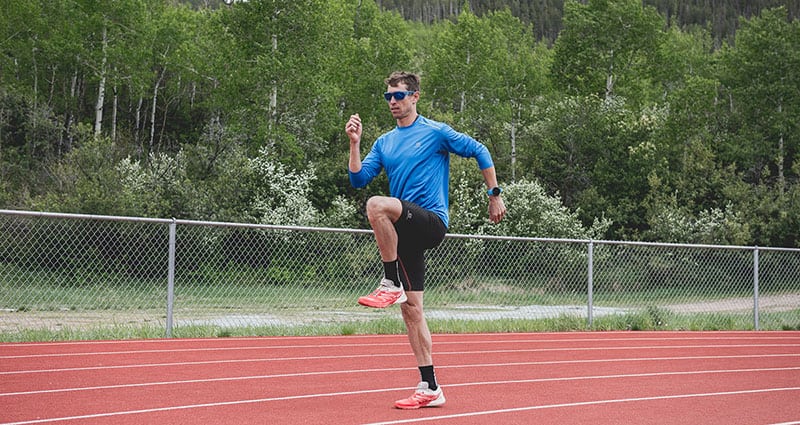How do you warm up before running? If you’re like most amateur runners, you do some easy running before getting into a faster gear, and that’s about it—at the expense of your health and performance.
“A warm up before running improves workout performance and reduces injury risk.”
Sure, we are all pressed for time. I get it. But a solid warm-up doesn’t mean you have to spend 20 – 30 minutes for it as Olympians do. It can be done in half that time.
The Benefits of Warming Up
At rest, only about 20 percent of your blood is directed to your muscles. Much of your blood is “stored” in your liver, kidneys, and brain. But this changes dramatically during intense exercise, where well above 80 percent of your blood is directed to your working muscles. A warm-up facilitates this process by raising your heart rate, increasing body temperature, and releasing hormones conducive to performance.
The other major reason for warming up is the increased range of motion. Don’t expect to run with good posture after sitting in an office chair for hours. Postural inadequacies are a common cause of injury, not to mention the inefficiency of movement that is likely holding you back from faster running times.
There is also a psychological benefit to a warm-up. Your sympathetic nervous system – think “fight-or-flight” response – gets revved up, which puts you in a state of mind that anything is possible.
The Elements of a Warm-Up
Every warm-up starts with 5 minutes of jogging. Notice that I said “jogging” and not running. It should be at least 90 seconds per mile slower than your usual easy pace. You’re going too fast if your heart rate is above 120 bpm by the end of this initial warm-up stage. That is sufficient to increase blood flow to your muscles and raise your body temperature.
The next step is mobility work to increase your range of motion specific to the demands of running. Stretching can be static or dynamic. While static stretching is beneficial after workouts, dynamic stretching is the preferred mode for warming up.
Dynamic stretches:
- Dynamic quad stretch
- Hamstring sweeps
- Forward leg swings
- Lateral leg swings
- Knee hugs
- Table tops
- Goblet squat
- Toe walks
- Heel walks
Once you have done some basic mobility work, you can up the ante with running drills. Although including drills before every run is optional, you should make them mandatory at least twice a week before faster workouts such as tempo runs, intervals, and repetitions.
Running drills:
- Power skips
- High knees
- Butt kicks
- A-skips
- B-skips
- Backward running
- Side shuffle
- Carioca
- Fast feet
A warm-up before running doesn’t have to include all dynamic stretches or drills mentioned here. Start with a few if you haven’t done any before.
Warm-Ups for Different Workout Types
The warm-up for easy and long runs is pretty straightforward. Jogging for 5 minutes, some dynamic stretching, and you’re ready.
For workouts in the range of marathon pace up to lactate threshold (~15K pace), you should include an additional 1 – 2 miles at an easy pace after your basic warm-up of jogging and mobility work. The segment at the lactate threshold may only be as long as 3 miles, after all. That way, you’re adequately warmed up for the main set and increase your weekly mileage without overreaching.
Anything faster than lactate threshold pace – intervals and repetitions – requires an extended warm-up. Follow the guidelines for tempo runs and add running drills and accelerations. An example would be 100m repeats with a flying start, where you increase the pace gradually toward 400m race pace.
The Cool-Down & Static Stretching
Just as you need to warm up to get your body ready for running, the cool-down helps you to return to homeostasis. It metabolizes waste products from your muscles, making you feel better in the next workout. It will also calm you down after a workout, as anyone who did a demanding speed session in the evening and couldn’t find sleep can testify.
A cool-down will be 1 – 2 miles after VO2max workouts. Glycogen stores, especially in fast-twitch fibers, can be depleted after such efforts, so there’s no point in aggravating this. This is true to a lesser extent for tempo runs of all sorts, but 1 – 2 miles cooling down is still a good number to aim for.
Easy runs and long runs are exempt from cooling down. You want to end long runs on a fast note to train your body to hold on to speed despite accumulated fatigue. And who wants to run a cool-down anyway after a 15-miler?!
However, you should stretch after every workout. Whether you jump in the shower first is up to personal preference, but do it within 30 minutes after your run while your muscles are still warm.
Static stretches:
- Standing quad stretch
- Hamstring stretch
- Hip adductor stretch
- Piriformis stretch
- Hip-flexor stretch
- Lower back stretch
- Glute stretch
- Straight leg calf stretch (gastrocnemius)
- Bent leg calf stretch (soleus)





